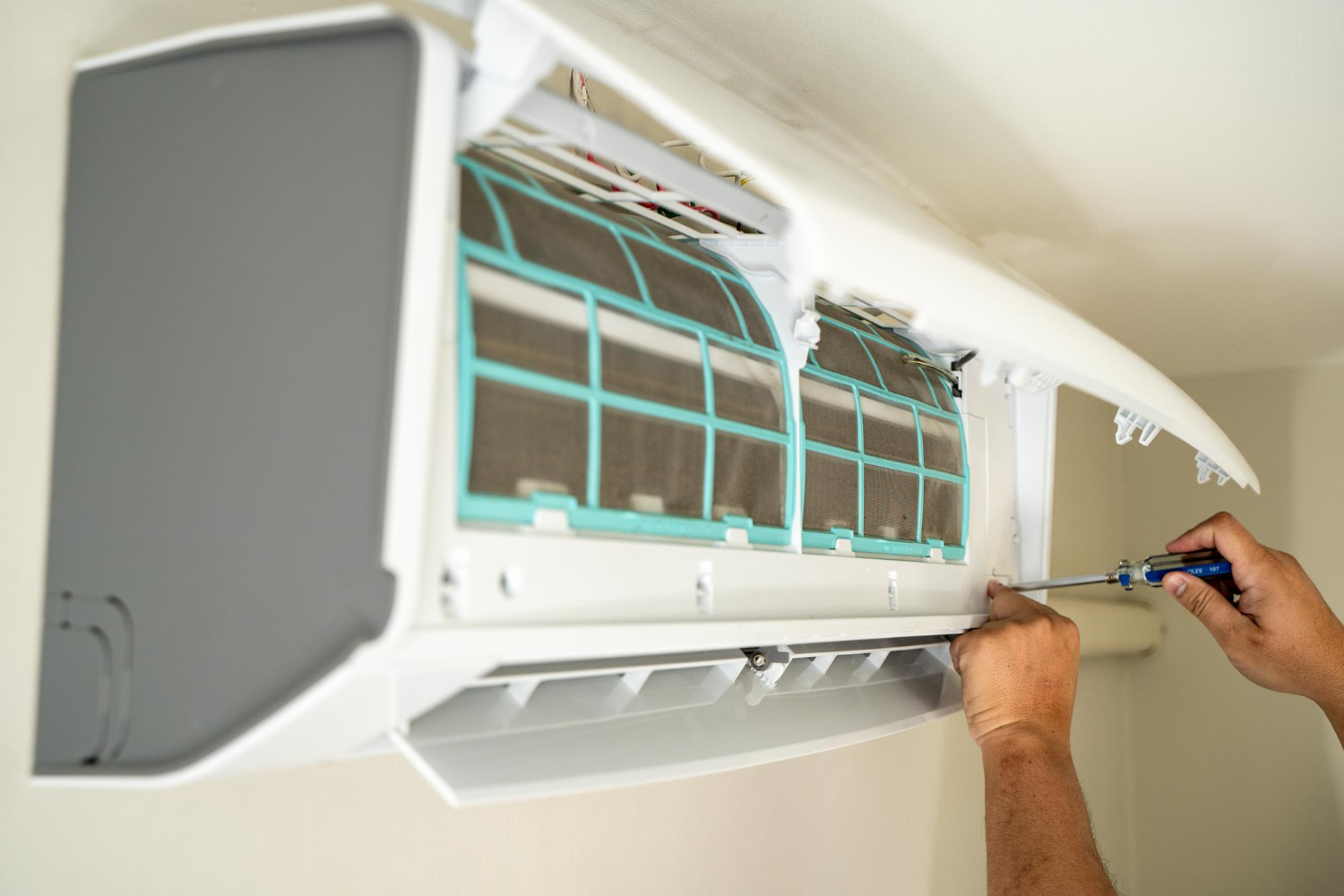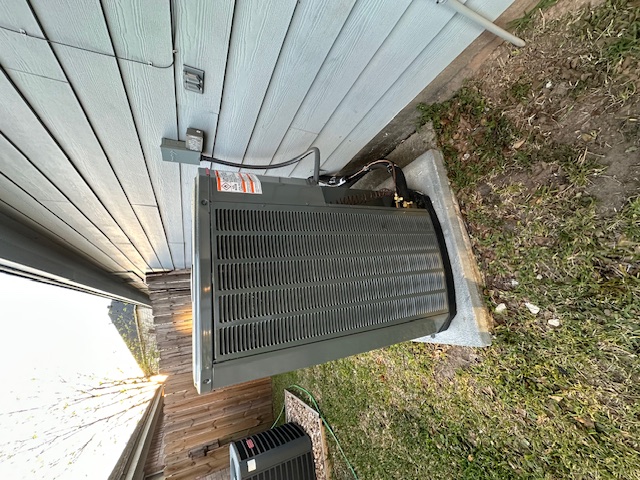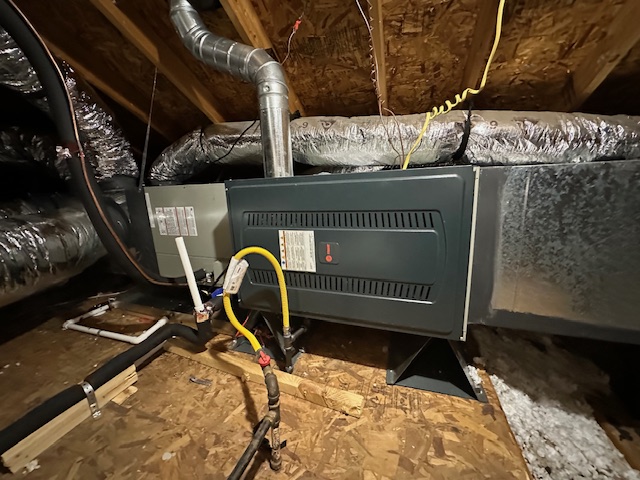Ductless mini split systems provide efficient heating and cooling for homes without traditional ductwork, but like any HVAC equipment, they can develop problems over time. These systems are popular choices for room additions and older homes because they offer flexible temperature control and energy savings.
When a ductless mini split starts making unusual noises, blowing warm air during cooling mode, or struggling to maintain set temperatures, it likely needs professional repair. Common issues include refrigerant leaks, electrical problems, dirty filters, and mechanical wear that can affect performance and increase energy costs.
The right approach to repairs and regular upkeep can extend equipment life while keeping indoor comfort consistent throughout the year.
In this article, you’ll learn how to handle ductless mini split repair—from fast troubleshooting and typical costs to repair-vs-replace decisions in Houston.
Here’s what you need to know.
- Signs your mini split needs repair now
- What happens during a ductless mini split repair visit
- Cost, value, and when repair beats replacement
- Simple maintenance moves that prevent the next breakdown
- Choosing the right HVAC partner in Houston
Keep reading! Understanding warning signs, repair processes, and maintenance basics helps homeowners make smart decisions about their systems.
Signs your mini split needs repair now
Mini splits show clear warning signs before they fail completely. Quick action on these symptoms can prevent costly breakdowns and extend system life.
Warm spots or weak airflow and what they reveal
Weak or uneven airflow is one of the first signs of trouble. Rooms may feel stuffy or fail to reach the set temperature.
Dirty filters are the most common cause. Clogged filters block air movement and make the system work harder. Check filters monthly and clean or replace them when dirty.
Blocked vents also reduce airflow. Make sure nothing sits in front of indoor or outdoor units. Furniture, curtains, or debris can restrict air movement.
Fan problems create more serious issues. A failing fan motor produces weak airflow throughout the space. Strange sounds from the fan area often accompany this problem.
Refrigerant leaks cause uneven cooling patterns. Some areas stay warm while others get cold. Low refrigerant also makes the system run constantly without reaching target temperatures.
Odd noises or smells and when to shut it off
Mini splits run quietly during normal operation. Loud or unusual sounds mean something needs attention right away.
Grinding noises suggest motor bearings are wearing out. This sound gets worse over time and can lead to complete motor failure.
Rattling sounds often come from loose parts or debris inside the unit. Small objects can damage fan blades or other moving parts.
Electrical smells require immediate shutdown. Turn off the system and call a technician right away. Burning odors can indicate dangerous wiring problems.
Musty odors point to mold or bacteria growth. Dirty coils or drain problems create moisture buildup. Clean the unit and check drainage to prevent health issues.
High-pitched squealing usually means belt or bearing problems. While not immediately dangerous, these issues worsen quickly without repair.
Leaks, error codes, and quick checks that save a service call
Water leaks around indoor units signal drainage problems. Check the condensate drain line for clogs first.
Drain line issues are often easy fixes. Pour water through the drain to test flow. Clear small clogs with a wet vacuum or pipe cleaner.
Error codes on the display help identify specific problems. Write down any codes before calling for service. Many manuals list common codes and simple solutions.
Ice buildup on outdoor units during summer indicates serious problems. Low refrigerant or airflow issues cause this freezing. Turn off the system until ice melts completely.
Check electrical connections if the unit won't start. Loose plugs or tripped breakers cause many service calls. Reset any tripped circuit breakers before calling for help.
Remote control problems often need new batteries. Try fresh batteries and check for obstructions between the remote and unit sensor.
What happens during a ductless mini split repair visit
Professional technicians follow a systematic approach to diagnose problems, explain necessary repairs, and ensure proper parts installation. Understanding this process helps homeowners make informed decisions about their ductless AC repair needs.
The diagnostic flow techs use to find the root cause
Technicians start by checking electrical connections and power supply to the indoor and outdoor units. They use multimeters to test voltage levels and ensure proper current flow.
Next, they examine refrigerant lines for leaks or damage. Pressure gauges help measure refrigerant levels in the system.
The tech inspects both indoor and outdoor coils for dirt buildup or damage. Dirty coils reduce efficiency and cause common cooling problems.
Filter inspection comes next. Clogged filters restrict airflow and strain the system.
Finally, technicians test system controls and thermostat communication. They run the unit through heating and cooling cycles to identify performance issues.
Many techs use diagnostic tools like:
- Digital manifold gauges
- Leak detectors
- Temperature probes
- Amp clamps
Common fixes homeowners should recognize before approving work
Filter replacement is the most basic repair. Clean filters cost $15-30 and take minutes to install.
Coil cleaning removes dirt and debris that blocks airflow. This service typically costs $100-200 and improves efficiency immediately.
Refrigerant leaks require finding the hole and adding new refrigerant. Small leaks cost $200-400 to fix, while major line replacements cost more.
Electrical repairs include replacing contactors, capacitors, or wiring. These parts usually cost under $150 plus labor.
Drain line clogs cause water backup. Technicians clear blockages with special tools or wet vacuums for $75-150.
Remote control or thermostat issues often need simple battery changes or reprogramming. More complex control boards cost $200-500 to replace.
Parts availability, timelines, and how to avoid repeat failures
Common parts like filters, contactors, and capacitors are available same-day from local suppliers. Most techs carry these basic components on their trucks.
Specialized parts like control boards or compressors may take 1-3 days to order. Some older models require 1-2 weeks for parts delivery.
Compressor failures are major repairs requiring factory parts with 5-10 year warranties. These repairs can take several days to complete.
To prevent repeat problems, technicians recommend:
- Monthly filter changes during heavy use seasons
- Annual professional maintenance visits
- Keeping outdoor units clear of debris
Warranty coverage affects repair timelines. Parts under warranty may take longer to approve through manufacturers but reduce customer costs significantly.
Regular maintenance prevents 80% of common failures. Systems with annual service calls rarely need emergency repairs during peak seasons.
Cost, value, and when repair beats replacement
Smart decisions about mini split repairs depend on understanding typical costs and weighing them against your system's age and condition. Most repairs cost between $50 and $1,500, but the 50% rule and system age help determine when replacement makes more financial sense.
According to the U.S. Department of Energy, duct losses can account for more than 30% of space-conditioning energy use, especially when ducts run in unconditioned areas, so ductless mini splits avoid a major efficiency penalty
How much mini split repair costs in typical scenarios
Mini split repair costs vary widely based on the type of problem and parts needed. Simple maintenance tasks cost much less than major component replacements.
Basic repairs and maintenance:
- Filter replacement: Under $50
- Refrigerant refill: $150-$300
- Thermostat issues: $100-$250
Moderate repairs:
- Fan motor replacement: $200-$500
- Control board problems: $300-$600
- Electrical component fixes: $150-$400
Major repairs:
- Compressor replacement: $600-$1,500
- Condenser coil repair: $500-$1,200
- Complete refrigerant line replacement: $400-$800
Labor costs typically add $75-$150 per hour to parts expenses. Service call fees range from $50-$100 before any work begins.
Older systems often cost more to repair because parts become harder to find. Systems over 10 years old may require special ordering of components, which increases both parts costs and labor time.
Are mini splits worth repairing and how to decide with confidence
The 50% rule provides a clear guideline for repair versus replacement decisions. When repair costs approach half the price of a new system, replacement usually offers better long-term value.
Signs repair makes sense:
- System is under 8 years old
- Repair costs less than $800
- Only one component needs fixing
- Unit has been reliable overall
Signs replacement is better:
- Multiple components failing simultaneously
- Repair costs exceed 50% of new system price
- Frequent breakdowns requiring service calls
- System struggles to maintain temperature
Energy efficiency plays a major role in this decision. Newer systems use 20-30% less energy than models from 10 years ago.
Calculate potential energy savings over 5-10 years when considering replacement. Higher efficiency ratings translate to lower monthly utility bills that help offset the initial investment cost.
Lifespan of a ductless system and the best time to invest
Most ductless mini splits last 15-20 years with proper maintenance. The sweet spot for replacement typically falls between years 10-15 when efficiency drops and repair frequency increases.
Systems under 5 years old rarely need major repairs beyond basic maintenance. Years 5-10 represent the most reliable period with occasional moderate repairs.
Age-based replacement guidelines:
- 0-5 years: Repair almost always makes sense
- 6-10 years: Evaluate repair costs carefully
- 11-15 years: Consider replacement for major repairs
- 15+ years: Replace unless repair is very minor
Regular maintenance extends system life significantly. Annual professional service prevents many common failures and keeps efficiency high.
The best time to replace is during off-peak seasons when contractors offer better pricing. Spring and fall installations typically cost 10-20% less than summer emergency replacements.
Simple maintenance moves that prevent the next breakdown
Regular filter cleaning, outdoor unit clearance, and seasonal check-ups stop most mini split failures before they start. These basic tasks take minutes but save hundreds in repair costs.
Filter, coil, and drain care that boosts efficiency fast
ENERGY STAR advises checking HVAC filters every month and replacing them at least every 3 months; a dirty filter slows airflow and makes the system work harder—wasting energy and risking early system failure.
Clean filters monthly to keep air flowing freely. Dirty filters make the system work harder and use more energy.
Pull the front panel open and slide out the filters. Rinse them with warm water and let them dry completely before putting them back.
Wipe down indoor coils every three months. Use a soft brush or cloth to remove dust buildup on the coils behind the filters.
Check the drain pan under the indoor unit for standing water or clogs. Pour a cup of water into the drain to make sure it flows out properly.
Signs your system needs attention:
- Weak airflow from the unit
- Ice forming on coils
- Water dripping inside
- Higher electric bills
Clean coils help the system cool faster and use less power. A clogged drain can cause water damage to walls and floors.
Outdoor unit clearance and airflow tips for steady cooling
Keep two feet of clear space around the outdoor unit on all sides. Remove leaves, grass clippings, and debris from around the unit every month.
Trim bushes and plants that grow too close to the unit. Good airflow prevents the system from overheating and shutting down.
Check the outdoor coils for dirt and debris. Spray them gently with a garden hose from the inside out. Never use a pressure washer as it can bend the fins.
Make sure the unit sits level on its pad. A tilted unit can cause drainage problems and extra wear on parts.
Protect the unit during storms by securing loose items in your yard. Heavy objects can damage the fan or coils if blown into the unit.
In winter, remove snow and ice buildup around the unit. The system needs airflow even when heating your home.
Seasonal tune up checklist for fewer surprises
Spring preparation gets your system ready for summer heat. Test both heating and cooling modes before peak season starts.
Check all remote control batteries and clean the sensors on indoor units. Replace batteries twice per year to avoid surprises.
Summer tasks include checking refrigerant lines for damage or loose insulation. Look for oil spots or ice buildup that signal refrigerant leaks.
Monitor energy bills for sudden increases that point to system problems. Higher bills often show up before other symptoms.
Fall maintenance prepares the system for heating season. Clean outdoor coils thoroughly after leaves stop falling.
Winter checks focus on keeping outdoor units clear of snow and ice. Never use hot water or sharp tools to remove ice from the unit.
Schedule professional maintenance every six months for best results. Technicians catch small problems before they become expensive repairs.
Choosing the right HVAC partner in Houston
Finding the right repair company makes the difference between a quick fix and ongoing problems with your ductless mini-split system. The best partners offer specialized expertise, clear communication, and strong guarantees that protect your investment.
What Horizon Air Solutions does differently for mini splits
Horizon Air Solutions focuses on ductless systems as a core service. Their technicians receive specific training on mini-split components like refrigerant lines, condensate drains, and indoor air handlers.
The company stocks common parts for major brands. This means faster repairs without waiting days for special orders. Their service trucks carry replacement filters, remote controls, and electrical components.
Diagnostic approach:
- Digital leak detection tools
- Refrigerant pressure testing
- Electrical system analysis
- Indoor air quality checks
They provide detailed repair estimates before starting work. Customers know exactly what needs fixing and why. The team explains each step in simple terms.
Horizon Air Solutions offers same-day service for urgent repairs. They understand Houston's heat makes working air conditioning essential. Their scheduling system prioritizes emergency calls during peak summer months.
Questions to ask before you book a repair visit
Smart homeowners ask specific questions before hiring any repair service. These questions reveal the company's expertise and reliability.
Essential questions to ask:
- Do you specialize in ductless mini-split systems?
- What brands do you service most often?
- How long have your technicians worked on mini splits?
- Do you provide written estimates?
Ask about diagnostic fees and whether they apply to the final repair cost. Some companies waive diagnostic charges when customers approve repairs.
Find out their parts policy. Quality companies use manufacturer parts or approved equivalents. Avoid services that install generic components without your knowledge.
Scheduling questions:
- What are your typical response times?
- Do you charge extra for weekend or evening calls?
- How far in advance do I need to schedule?
Request references from recent customers. Established companies gladly share contact information for satisfied clients.
Warranty, guarantees, and proof you can trust
Reputable repair services back their work with solid warranties. These guarantees protect customers from faulty repairs and poor workmanship.
Standard warranty coverage includes:
- Parts warranty: 90 days to 1 year
- Labor warranty: 30 to 90 days
- Refrigerant leaks: 1 year guarantee
- Electrical work: 90 days minimum
Ask for warranty details in writing. Verbal promises mean nothing when problems arise later. Good companies provide warranty cards or certificates.
Check the company's licensing and insurance status. Licensed contractors must meet state training requirements. Insurance protects homeowners from liability during repairs.
Verification steps:
- Confirm license number with state board
- Request proof of insurance coverage
- Check Better Business Bureau ratings
- Read online customer reviews
Look for companies with established local addresses. Avoid services that only provide phone numbers or PO boxes. Physical locations show commitment to the community.
Payment terms matter too. Professional services accept multiple payment methods and provide detailed invoices. Be cautious of companies demanding full payment before starting work.
Conclusion
Taking care of a ductless mini split system requires regular attention and quick action when problems arise. These systems work well when properly maintained and repaired promptly.
Most common problems have simple solutions. Strange noises often mean loose parts or debris that can be fixed quickly. Poor cooling usually comes from dirty filters or blocked vents.
Regular maintenance prevents most major repairs. Small problems become expensive fixes when ignored. Acting fast saves money and extends system life.
Professional technicians have the right tools and knowledge for complex repairs. They can spot problems early and fix them safely.
A well-maintained ductless mini split system provides comfortable temperatures year-round. These systems last longer and work better with proper care. Simple maintenance tasks and quick repairs keep them running efficiently.
The investment in regular maintenance pays off through lower energy bills and fewer emergency repairs. Understanding basic troubleshooting helps homeowners know when they can fix problems themselves and when to call experts.
Schedule your ductless mini split repair and seasonal maintenance today to restore cooling fast, prevent repeat issues, and keep energy costs under control.











